Acanthodians — Spiny Sharks
|
There has been a lot of debate about where the Acanthodians fit in the fish phylogeny, but recent studies suggest they are ancestors to the Chondrichthyes (cartilagenous fishes). They lacked bony armor plates but had large scales (which include layers of bone-like material) and spines on their fins.
Their internal skeleton was cartilagenous, so fossils showing the entire animal, such as this one of Acanthodes bridgei, are rare.
Taxonomy: Acanthodii; Acanthodiformes; Acanthodidae
Hamilton Quarry, Greenwood Co., KS
Carboniferous Period, Pennsylvanian Epoch
Black Hills Institute Museum, South Dakota
|

|
|
|
This fossil of Diplacanthus striatus shows the numerous well-developed spines of this group.
Taxonomy: Acanthodii; Diplacanthiformes; Diplacanthidae
Scotland
Devonian Period
Chicago Field Museum
|
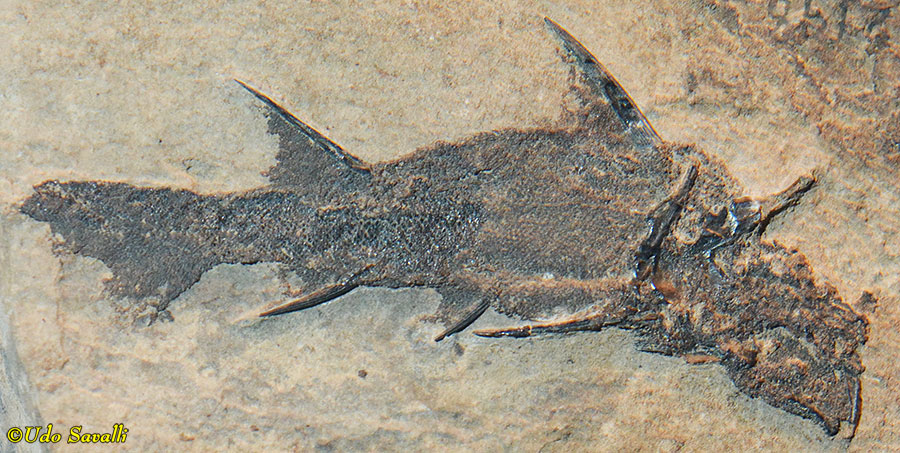
|
|
|
Fossil of Cheiracanthus sp.
Taxonomy: Acanthodii; Acanthodiformes; Cheiracanthidae
Scotland
Devonian Period
Chicago Field Museum
|

|
|
|
Acanthodes bridgei.
Taxonomy: Acanthodii; Ischnacanthiformes; Ischnacanthidae
Scotland
Devonian Period
Chicago Field Museum
|
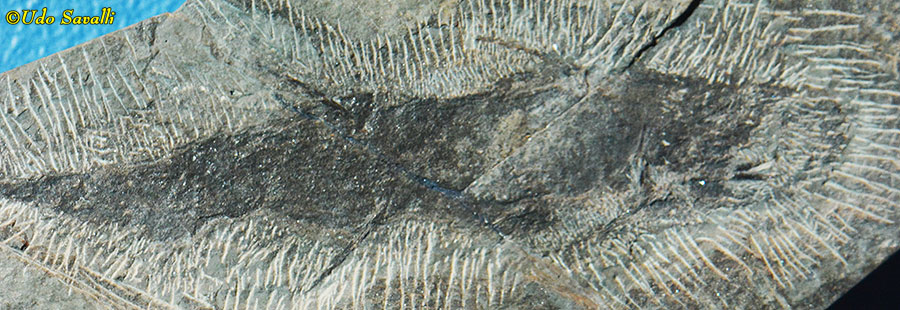
|
|
|
Life model of Acanthodes sp.
Taxonomy: Acanthodii; Acanthodiformes; Acanthodidae
Carboniferous to Permian Periods, 409-284 Ma
Museum of Ancient Life, Utah
|

|
|
Chondrichthyes — Cartilagenous Fishes (Sharks, Rays, Etc.)
Holocephali — Chimaeras & Relatives
|
Chondrichthyes means "cartilage fish" and reflects their cartilagenous skeleton (jaws can become mineralized but this is not true bone). Unlike more primitive fish, they lack the bony dermal armor plates, so except for their teeth, they rarely fossilize except under rare conditions. There are two major clades of the Chondrichthyes, the elasmobranchi (sharks & skates, covered below) and the Holocephali. This latter group has a few surviving members, the deep-sea chimaeras or ratfishes, but a more extensive fossil record.
Echinochimera melton is one such extinct member of the Holocephali.
Taxonomy: Chondrichthyes; Holocephali; Chimaeriformes; Echinochimaeridae
Central Montana
Carboniferous Period, Mississippian Epoch, Bear Gulch Limestone, 320 Ma
Museum of the Rockies, Montana
|

|
|
|
Falcatus falcatus is a strange, primitive shark; the male's dorsal fin forms a forward-pointing prong that is hooked through the female's jaw during mating.
Taxonomy: Chondrichthyes; Holocephali; Symmoriida; Falcatidae
Fergus Co., Montana
Carboniferous Period, Mississippian Epoch, Bear Gulch Limestone, 320 Ma
Black Hills Institute Museum, South Dakota
|

|
|
|
Symmorium reniforme, a large shark-like holocephalan, and may be the female of Stethacanthus (see model below).
Taxonomy: Chondrichthyes; Holocephali; Symmoriida; Symmoriidae
Indiana
Carboniferous Period
Chicago Field Museum
|
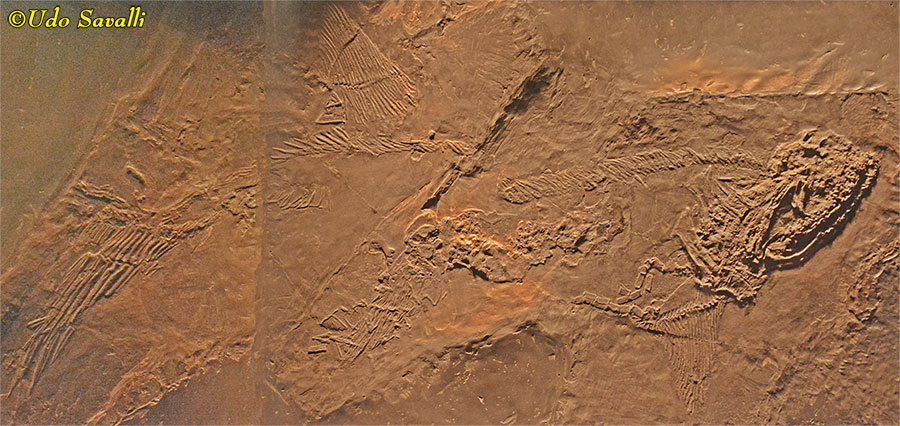
|
|
|
Orodus greggi is another large shark-like holocephalan, reaching up to 4 m long.
Taxonomy: Chondrichthyes; Holocephali; Orodontida; Orodontidae
Indiana
Carboniferous Period
Chicago Field Museum
|
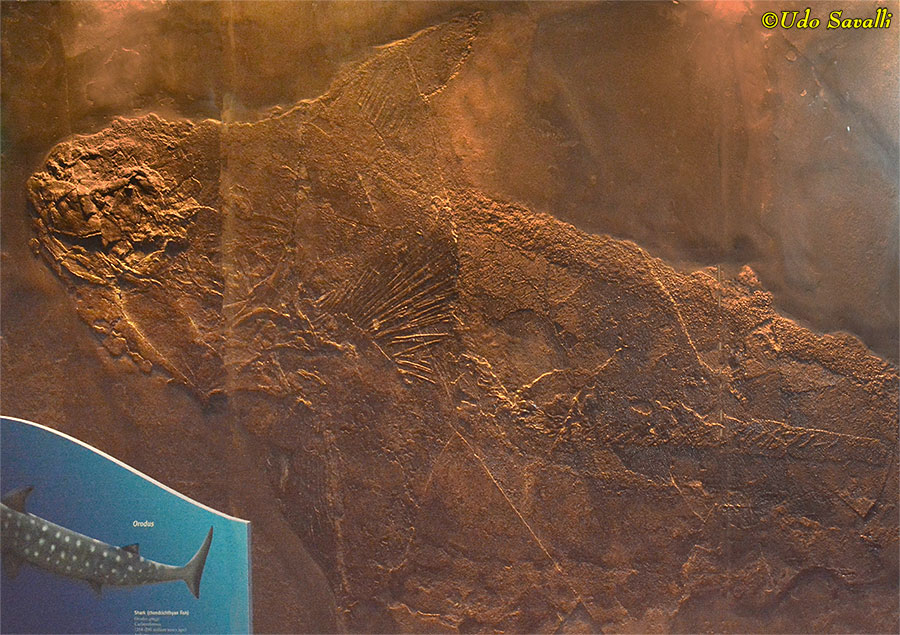
|
|
|
The fossil tooth whorl of Helicoprion ferrieri. The teeth are never shed, so they roll up in a whorl as new teeth grow in, so that the oldest teeth (when the shark was young) are in the center of the whorl. The whorl sits in the lower jaw and fits into a V-shaped groove in the toothless upper jaw, and may have functioned to extract molluscs from their shell.
Taxonomy: Chondrichthyes; Holocephali; Eugeneodontida; Helicoprionidae
Glass Mountains, Texas
Permian Period
Chicago Field Museum
|
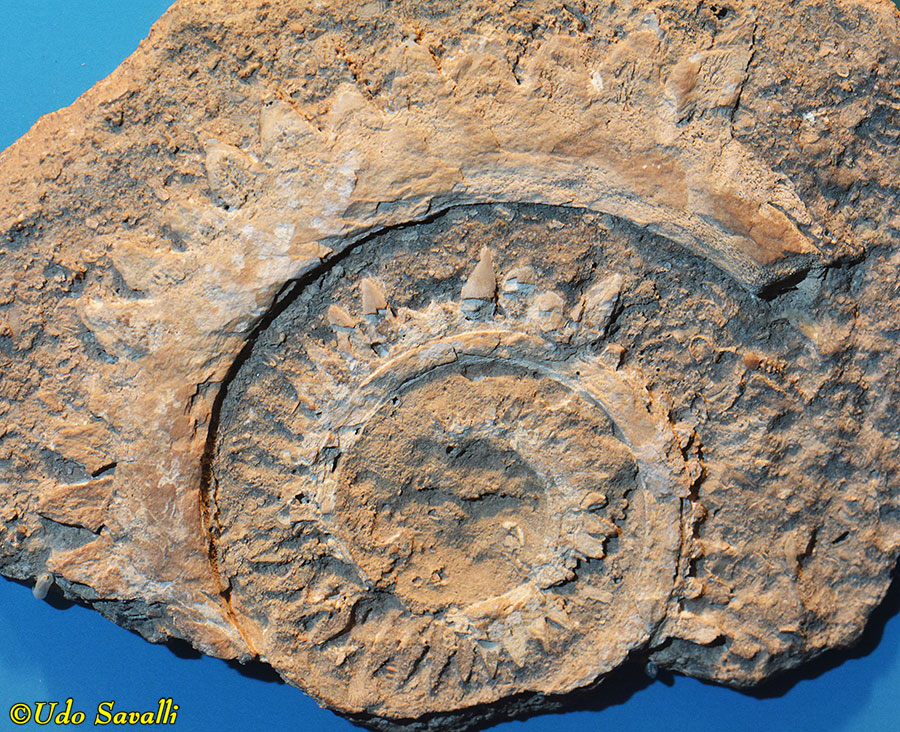
|
|
|
Life models of Belantsea montana and two small bradydont sharks, Harpagofututor volsellorhinus.
Taxonomy: Chondrichthyes; Holocephali; Petalodontiformes (Belantsea) and Holocephali; Chondrenchelyiformes (bradydonts)
Carboniferous Period
Arizona Museum of Natural History
|

|
|
|
Life model of Falcatus facatus (the unicorn shark). This is a male; females lack the spine-like dorsal fin.
Taxonomy: Chondrichthyes; Holocephali; Symmoriida
Carboniferous Period, Late Mississippian Epoch, 320 Ma; Montana
Museum of the Rockies, Montana
|

|
|
|
Life models of Echinochimera meltoni male and two smaller females.
Taxonomy: Chondrichthyes; Holocephali; Chimaeriformes
Carboniferous Period, Late Mississippian Epoch, 320 Ma; Montana
Museum of the Rockies, Montana
|

|
|
|
Life model of Cladoselache sp.
Taxonomy: Chondrichthyes; Holocephali; Cladoselachiformes
Late Devonian Period
Museum of Ancient Life, Utah
|

|
|
|
Life model of Symmorium sp. (may be a female Stethacanthus).
Taxonomy: Chondrichthyes; Holocephali; Symmoriida
Carboniferous Period, Pennsylvanian Epoch
Arizona Museum of Natural History
|

|
|
|
Life models of Stethacanthus, the "ironing board shark." The female is in the foreground and the male, with his distinctive dorsal fin, is in the back.
Taxonomy: Chondrichthyes; Holocephali; Symmoriida; Symmoriidae
Carboniferous Period, Pennsylvanian Epoch, 320 Ma; Montana
Wyoming Dinosaur Center
|

|
|
Chondrichthyes: Elasmobranchi — True Sharks and Rays
|
The Elasmobranchii include the modern sharks, rays, and skates, as well as some primitive forms that are neither true sharks or rays.
This fossil is Xenacanthus sp., a very primitive 'shark' with a prominent dorsal spine.
Taxonomy: Chondrichthyes; Elasmobranchii; Xenacanthida; Orthacanthidae
Germany
Early Permian Period
Wyoming Dinosaur Center
|

|
|
|
Fossil of Orthocanthus sp. Its cartilage has been replaced by a white mineral.
Taxonomy: Chondrichthyes; Elasmobranchii; Xenacanthida; Orthacanthidae
Pfalz, Germany
Permian Period, 280 Ma
Tucson Gem & Mineral Show
|

|
|
|
This juvenile Bandringa rayi had a long, flat snout similar to that of a modern paddlefish. It is preserved in an ironstone concretion.
Taxonomy: Chondrichthyes; Elasmobranchii; Bandringidae
Mazon Creek, IL
Carboniferous Period
Chicago Field Museum
|
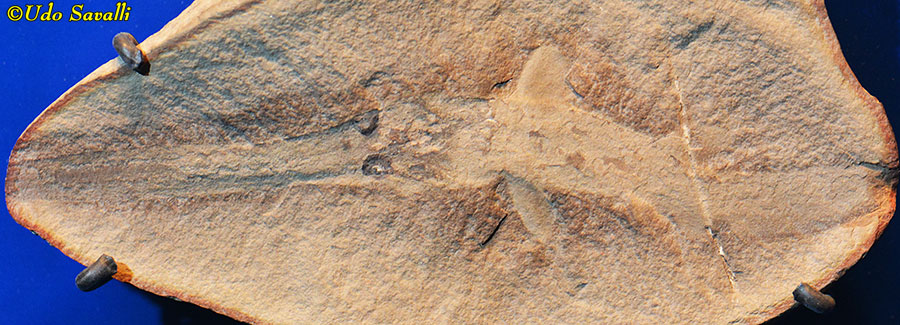
|
|
|
The clade Selachii includes all of the modern (true) sharks.
Cat shark, Scyliorhinus sp. This genus persists to this day.
Taxonomy: Chondrichthyes; Elasmobranchii; Selachii; Carcharhiniformes; Scyliorhinidae
Lebanon
Late Cretaceous Period, Cenomanian Stage
Black Hills Institute Museum, South Dakota
|

|
|
|
Cantioscyllium decipiens is a member of the nurse & carpet shark group.
Taxonomy: Chondrichthyes; Elasmobranchii; Selachii; Orectolobiformes; Ginglymostomatidae
Hjoula, Lebanon
Late Cretaceous Period, Cenomanian Stage, 110 Ma
Tucson Gem & Mineral Show
|
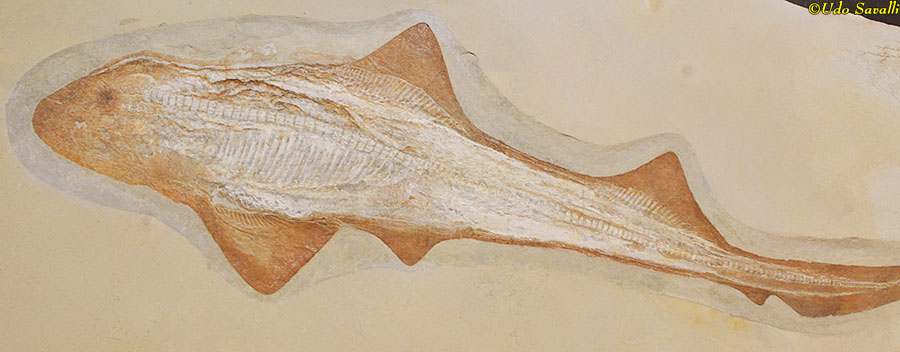
|
|
|
The clade Batoidea includes all of the modern rays and skates, with broad pectoral fins and flat bodies.
A guitarfish (a kind of ray), Rhinobatos sp., virtually unchanged from moderns species belonging to the same genus.
Taxonomy: Chondrichthyes; Elasmobranchii; Batoidea; Rajiformes; Rhinobatidae
Solnhofen Limestone, Germany
Late Jurassic Period, 150 Ma
Wyoming Dinosaur Center
|

|
|
|
Another guitarfish, Rhinobatos maronita.
Taxonomy: Chondrichthyes; Elasmobranchii; Batoidea; Rajiformes; Rhinobatidae
Lebanon
Late Cretaceous Period, 98 Ma
Museum of Ancient Life
|

|
|
|
Pararaja expansa ray.
Taxonomy: Chondrichthyes; Elasmobranchii; Batoidea; Rajiformes; Rajidae
Lebanon
Late Cretaceous Period, Cenomanian Stage
Black Hills Institute Museum, South Dakota
|

|
|
|
The sting-ray-like skate Cyclobatis major.
Taxonomy: Chondrichthyes; Elasmobranchii; Batoidea; Rajiformes; Cyclobatidae
Lebanon
Late Cretaceous Period, Cenomanian Stage, 98 Ma
Museum of Ancient Life, Utah
|

|
|
|
A sting-ray, Heliobatis radians.
Taxonomy: Chondrichthyes; Elasmobranchii; Batoidea; Myliobatiformes; Dasyatidae
Wyoming
Early Eocene Epoch, Green River Formation, 50 Ma
Wyoming Dinosaur Center
|

|
|
|
Another Heliobatis radians sting-ray.
Taxonomy: Chondrichthyes; Elasmobranchii; Batoidea; Myliobatiformes; Dasyatidae
Wyoming
Early Eocene Epoch, Green River Formation, 50 Ma
Wyoming Dinosaur Center
|
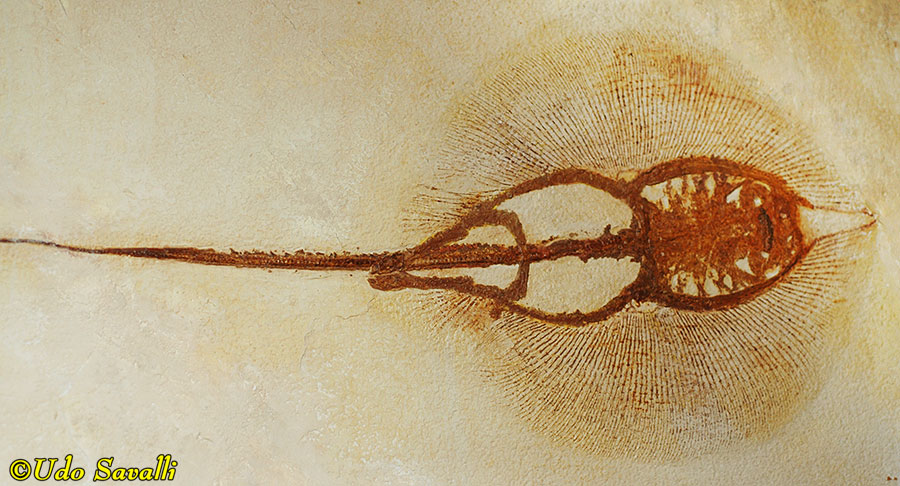
|
|
|
A pregnant stingray, Asterotrygon maloneyi with one embryo.
Taxonomy: Chondrichthyes; Elasmobranchii; Batoidea; Myliobatiformes; Urolophidae
Fossil Lake, Wyoming
Early Eocene Epoch, Green River Formation, 50 Ma
Chicago Field Museum
|
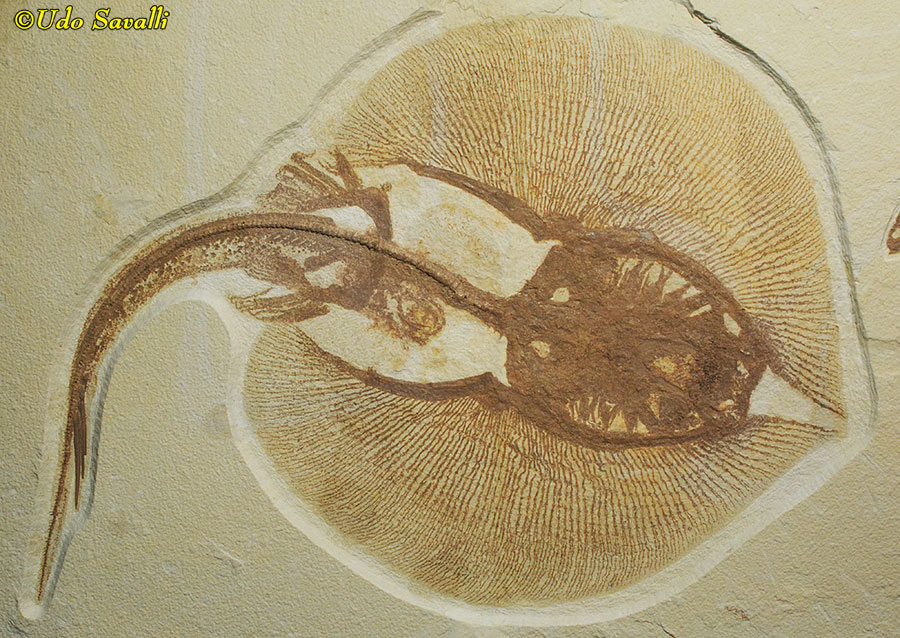
|
|
|
Micropristis solomonis sawfish had an elongated rostrum (snout) lined with tiny teeth that were used to hunt small fish.
Taxonomy: Chondrichthyes; Elasmobranchii; Batoidea; Rhinopristiformes; Rhinobatidae
Hadjula, Lebanon
Late Cretaceous Period, Cenomanian Stage
Black Hills Institute Museum, South Dakota
|

|
|
|




























